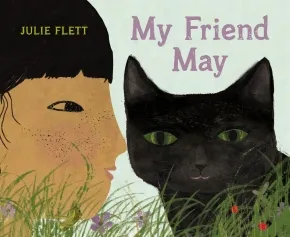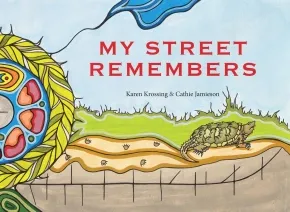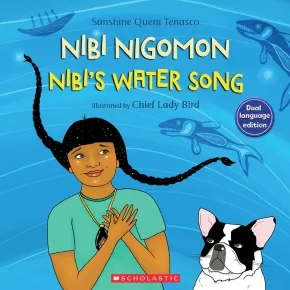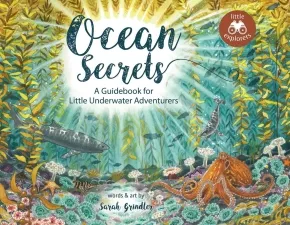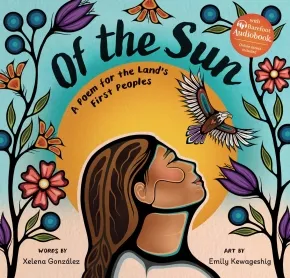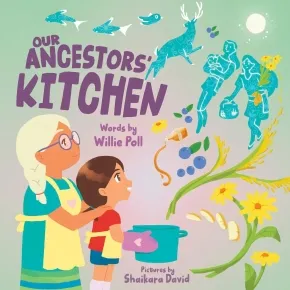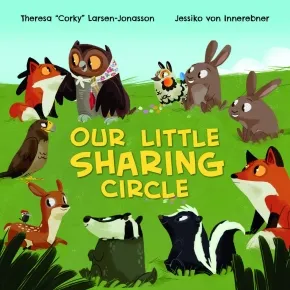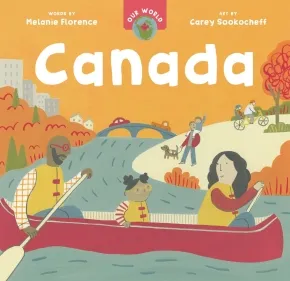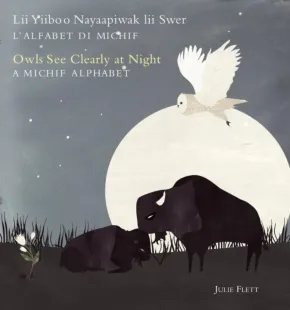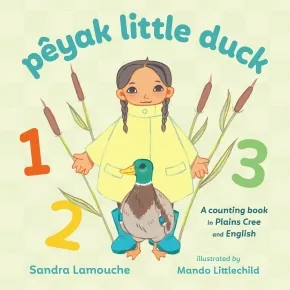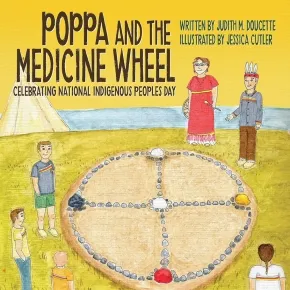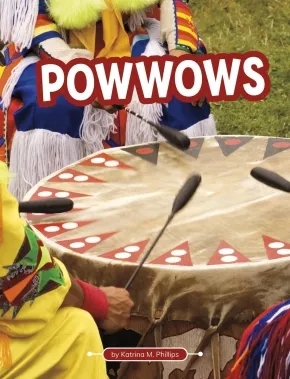
Preschool and Kindergarten
61
-
75
of
901 Results;
Sort By
Go To
of 61
My Friend May
$23.95
Artists:
Format:
Hardcover
Text Content Territories:
Indigenous Canadian; First Nations; Cree (Nehiyawak);
ISBN / Barcode: 9781778401718
Synopsis:
Synopsis:
From the winner of the New York Times Best Illustrated Book Prize and the American Indian Youth Literature Award
I’d like to tell you a rather true story about a big black cat who started out gray. Her name was May.
Margaux and her cat May became friends when Margaux was just six years old. They grew up together, sharing countless memories along the way. But one day, May is late coming home. Where is May? Is she under the porch? Maybe on the roof?
Margaux’s nitôsis (the Cree word for auntie) helps search for May in the tall grass. But soon nitôsis needs to leave: she’s moving away to the big city, and has to pack her things into boxes. Margaux helps nitôsis, but she can’t take her mind off May. Will she ever return? nitôsis is worried, too. But little do they know, May has a surprise in store for both of them!
This fun and heartwarming story with a surprise happy ending invites readers to share their own cat stories. My Friend May is a tribute to love and the balance between all beings, and the experiences and emotions that connect us all.
My Friend May features:
- A glossary of Cree words used throughout the book
- Backmatter content that includes a pronunciation guide
Reviews
"A quiet yet affectionate tribute to familial relationships of all stripes….Cat lovers… will particularly enjoy this sweet tale."—Kirkus Reviews
"From a talented picture book creator….Readers can reflect on great stories of their own encounters with beloved animal friends and share their tales with others….delightful.”—School Library Journal
"Award-winning author Julie Flett has created another beautiful story, perfect for read-alouds in kindergarten to grade three classrooms.... This heartwarming tale gently explores themes of love, loss, and reunion. With Flett’s signature artwork and tender storytelling, My Friend May will resonate with readers of all ages and spark connections to their own stories of friendship and change." - Debra H., Elementary School Teacher, Indigenous Books for Schools
Educator Information
Recommended for ages 4 to 8.
This title is included in the Indigenous Books for Schools database from the Association of Book Publishers of BC as a recommended resource for K to 3 English Language Arts.
Additional Information
40 pages | 11.00" x 9.00" | Hardcover
My Street Remembers
$21.99
Format:
Hardcover
Text Content Territories:
Indigenous Canadian;
ISBN / Barcode: 9781773066356
Synopsis:
Synopsis:
How many footsteps have walked your street in the past? My Street Remembers peels back the history of one city street in North America to reveal the greater story of the land on which we live.
The story begins 14,000 years ago, when mammoths roamed the icefields, and the First Peoples followed their trail. Historically accurate illustrations show the lives of their descendants over thousands of years as they hunted and gathered food, built homes and celebrated together, until the 1600s, when Europeans arrived with settlers in their wake.
In lyrical text, the street remembers agreements to live in peace, the efforts of the British to take the land with unfair treaties, and the conflict and suffering that followed. The street recalls its naming, paving and the waves of immigrants who called it home. Illustrations of recent times depict Canada's apology to Indigenous Peoples and efforts toward Truth and Reconciliation, including a march with a banner that reads: Every Child Matters.
This rich collaboration between author Karen Krossing, of White settler descent, and Anishinaabe artist Cathie Jamieson ends with a question that readers anywhere can ask-what does your street remember?
Reviews
"A thoughtful overview and reflection on the life and legacy of a busy street." — Booklist
Educator Information
Recommended for ages 3 to 6.
This book is part of the Better Path series.
Reading Levels: Lexile NC940L
Key Text Features:
- author's note
- bibliography
- captions
- explanation
- facts
- flags
- further information
- historical context
- historical note
- illustrations
- illustrator's notes
- sources
- timeline
- vignettes
- writing inspiration
Correlates to the Common Core State Standards in English Language Arts:
CCSS.ELA-LITERACY.RL.1.3
Describe characters, settings, and major events in a story, using key details.
Additional Information
48 pages | 11.00" x 8.00" | Hardcover
My Visit to Kimmirut
$16.95
Artists:
Format:
Paperback
Text Content Territories:
Indigenous Canadian; Inuit;
Grade Levels: Preschool; Kindergarten;
ISBN / Barcode: 9781774508060
Synopsis:
Synopsis:
What will Monica see and learn when she visits a new community?
Monica is visiting her aunt Peesee in Kimmirut, Nunavut. There are many wonderful things to see and do there. Monica is excited to explore and learn about her aunt's community. Join Monica and Peesee as they go clam digging, visit waterfalls, and see the tallest trees on Baffin Island in this bilingual picture book!
Reviews
"In the story, Monica shares about visiting her aunt in Kimmirut. At the beginning of the story, she explains that the village was renamed with its traditional name (Kimmirut) from its settler name (Lake Harbour). Different cultural elements are explored: resources, arts, food, activities, and land features. As well, there is an exploration of the seasons through images, contrasting the end of summer and winter. Teachers can point out to the students that with the exception of two pages, there are no trees on the landscape. This would be a good introduction to biomes and an inquiry into the arctic tundra. While the book is written for younger students, older students could benefit from the story and extend their learning by engaging in an inquiry project about the traditional Inuktitut names that are increasingly used in Nunavut in an effort to decolonize place names. For instance, Baffin Island’s traditional Inuktitut name is Qikiqtaaluk." - Alethea S., Indigenous Books for Schools
Educator & Series Information
Recommended for ages 3 to 5.
Dual-language: English and Inuktitut
This book is part of the Community Connections series.
This title is included in the Indigenous Books for Schools database from the Association of Book Publishers of BC, recommended for K-5 English Language Arts and Social Studies.
Additional Information
23 pages | 8.00" x 9.00" | Paperback
Nibi nigomon/Nibi's Water Song
$8.99
Format:
Paperback
Text Content Territories:
Indigenous Canadian; First Nations; Anishinaabeg;
ISBN / Barcode: 9781039700673
Synopsis:
Synopsis:
Nibi is determined to bring clean water to her community.
Nibi is the Anishinabemowin word for water. In Nibi’s Water Song, Nibi is an Indigenous girl on the search for clean water to drink. Though she is faced with repeated obstacles, Nibi’s joyful and determined energy becomes a catalyst for change and action as her community rallies around her to make clean drinking water available for all.
First published in 2020, Nibi’s Water Song was shortlisted for both the IODE Jean Throop Award and longlisted for the First Nations Communities READ Award. This dual-language edition presents the text in both English and Anishinabemowin.
Educator Information
Recommended for ages 4-8.
Dual-language: English and Anishinabemowin
Translated by Tina Nottaway. Tina is an Algonquin Anicinabe Ikwe artist and translator from Rapid Lake, Quebec. She is fluent in her language, Anicinabemowin. Tina is also a crafter and facilitates workshops on moccasin making, birchbark basket making and other cultural activities.
This resource is available in English: Nibi's Water Song
This resource is also available in French: Nibi a soif, très soif
Additional Information
32 pages | 9.51" x 9.51" | Paperback
Ocean Secrets: A Guidebook for Little Underwater Adventurers
$20.95
Artists:
Format:
Hardcover
ISBN / Barcode: 9781774713600
Synopsis:
Synopsis:
The newest book in the Little Explorers series takes young readers from the seashore to the ocean floor, finding fascinating plants and animals and solving ocean mysteries along the way.
Let's meet some of the amazing sea life that calls the ocean home.
What creatures live where there is no sunlight? How do tides work? Is coral a plant or an animal? Search for the answers to these questions and more in the newest book in the Little Explorers series! With engaging text and realistic illustrations, young readers will adventure through the fascinating underwater world of our planet's oceans.
Learn why some sea creatures glow, and how sharks can be as small as a pencil or as long as a bowling lane. From the helpful kelp forests of the shallow sunlight zone to the cold depths of the abyssal zone, interesting plants and animals abound—and many mysteries too.
Let's dive in!
Educator & Series Information
Recommended Ages: 4-8
This book is part of the Little Explorers Series.
Additional Information
32 pages | 8.00" x 6.50" | Hardcover
Of the Sun: A Poem for the Land's First Peoples
$22.99
Format:
Hardcover
Text Content Territories:
Indigenous American; Indigenous Canadian; Indigenous Caribbean; Indigenous Peoples in Mexico; Indigenous South American;
Grade Levels: Preschool; Kindergarten;
ISBN / Barcode: 9798888596500
Synopsis:
Synopsis:
A powerful and hopeful ode to Indigenous children.
Indigenous. Native. On this land, you may roam.
Child of the sun, on this land, you are home.
Of the Sun is an uplifting and mighty poem that wraps the Indigenous children of the Americas in reassuring words filled with hope for a brighter future and reminders of their bond and importance to the land. Each page fills them with pride and awe of their cultural heritage and invites them to unite and inspire change in the world.
Paired with powerful art reflecting cultures of various Indigenous Nations and Tribes, the poem offers all readers a sense of the history and majesty of the land we live on and how we can better care for ourselves and the world when we recognize our connection to the land and to each other.
Written by Xelena González, poet and activist in the Native and Latinx communities, and an enrolled member of the Tap Pilam Coahuiltecan Nation. Bold illustrations by prominent Anishinaabe illustrator Emily Kewageshig depict landscapes across the Americas and children from many backgrounds
Endnotes provide more information on Native and Indigenous unity and activism in younger generations
Reviews
"Of The Sun is a loving homage to the Indigenous peoples of this land—both in González’s beautiful, lyrical poem and Kewageshig’s warm, vibrant Anishinaabe-styled artwork. A wonderful read aloud you must add to bookshelves at home, at school, and in community!" - Traci Sorell, award-winning author of We Are Grateful Otsaliheliga and At The Mountain’s Base
"A luminous song, poem, promise
of cultures and connection,
of kinship and caring,
for Indigenous children across the continent." - Cynthia Leitich Smith, author of Jingle Dancer
Educator Information
Recommended for ages 3 to 5.
Subjects / Themes / Topics Included: Indigenous Peoples in the Americas; Poetry; Land Connection; Inuit Clothing; Traditional Hair Bun (tsiiyéél); Concheros Dance; Three Sisters; La Danza de la Flor de Piña; Smoke Dance; Jingle Dress Dance; Manoomin (Wild Rice); English Words from Indigenous Languages; Indigenous Farming Practices; Bison; Land Back Movement.
Additional Information
32 pages | 10.00" x 9.75" | Hardcover
Our Ancestors' Kitchen
$23.99
Format:
Hardcover
Text Content Territories:
Indigenous Canadian;
ISBN / Barcode: 9781773219622
Synopsis:
Synopsis:
A poignant and poetic picture book celebrating traditional Indigenous harvesting, foods, and the connections that these build for all our relations.
It’s a special day: the young protagonist in this memorable story is learning her grandfather’s favorite recipe from her grandmother! As each ingredient is prepared for this special dish, readers will be eager to follow along as they are transported back to each instance of gathering, hunting, and harvesting foods in the traditional ways throughout the seasons.
Willie Poll’s poetic voice leads the readers through the seasons and what Mother Earth offers to us in nature in this beautiful celebration of the Earth, our foods, our family, and the importance of grieving those we love. With an emphasis on the importance of thanking the land for what is given to us, sharing with our community, and offering a plate to our ancestors, this gentle and thoughtful tale will resonate with readers young and old alike. Shaikara David’s bright and inviting illustrations carry the cooking experience from the kitchen, to the forest, and back again.
Featuring an author’s note on traditional harvesting practices and a recipe for Nuwish, Our Ancestors’ Kitchen is a joyous exploration of love, food, and culture.
Educator Information
Recommended for ages 4 to 7.
Additional Information
36 pages | 9.75" x 9.75" | Hardcover
Our Little Sharing Circle (BB)
$13.95
Artists:
Format:
Board Book
Text Content Territories:
Indigenous Canadian; First Nations;
ISBN / Barcode: 9781778540769
Synopsis:
Synopsis:
In our little sharing circle…We care…We share… Our Little Sharing Circle is a gentle introduction to sharing, listening, and learning in the sharing circle. Our Little Sharing Circle is based on the bestselling picture book, The Sharing Circle.
Educator Information
Recommended for ages 3 and under.
This book is based on the picture book The Sharing Circle.
Additional Information
10 pages | 6.00" x 6.00" | Board Book
Our World: Canada (BB)
$12.99
Artists:
Format:
Board Book
Text Content Territories:
Indigenous Canadian; First Nations; Cree (Nehiyawak);
Grade Levels: Preschool;
ISBN / Barcode: 9798888596685
Synopsis:
Synopsis:
Good morning! Bonjour! Tānisi! Spend a day in Canada. Eat soft crepes with sticky maple syrup, play with atimwak in the snow and cache-cache in the park, and zip and zoom around the ice rink. Even learn words in French and Cree with pronunciation guides throughout the story.
Endnotes provide more insights into life in Canada.
Educator Information
Recommended for ages 2 and 3.
This book includes multicultural content about life in Canada. It includes some French and Cree words/phrases.
Additional Information
20 pages | 6.70" x 6.50" | Boardbook
Owls See Clearly at Night/Lii Yiiboo Nayaapiwak lii Swer: A Michif Alphabet/L'Alfabet Di Michif
$25.85
Artists:
Format:
Hardcover
Text Content Territories:
Indigenous Canadian; Métis;
ISBN / Barcode: 9781772290592
Synopsis:
Synopsis:
This picture book is a small glimpse, from A to Z, of some of the sights and sounds of the Michif language and its speakers.
The language of the Metis, Michif is a combination of French and Cree with a trace of other regional languages. Once spoken by thousands of people across the prairies of Canada and the northern United States, Michif is now so little spoken that it might disappear within a generation.
This alphabet book is part of a resurgence to celebrate and preserve the traditions of the Metis people. Here Michif and English words combine with images from Metis culture to introduce all generations to the unique Michif language. The book even includes a brief introduction to the language's history, a pronunciation guide, and a list of references for those interested in learning more about Michif.
Educator Information
Recommended for ages 5 to 8.
Dual-language: English and Michif.
Additional Information
56 pages | 8.25" x 9.00" | Hardcover
Petit Loup
$14.95
Artists:
Format:
Paperback
Text Content Territories:
Indigenous Canadian; First Nations; Heiltsuk (Bella Bella);
ISBN / Barcode: 9781772035100
Synopsis:
Synopsis:
En plein cœur de la ville, sur une rue très animée, Petit Loup aime s’assoir sur les marches du perron chez sa grand-mère. Parfois, les odeurs de la forêt lui manquent tellement qu’elle hurle à la lune. Ce chant animal réjouit son cœur.
Petit Loup est venue habiter en ville avec sa mère et sa sœur, mais l’ajustement n’a pas été facile. La nature et les animaux lui manquent terriblement. Le territoire traditionnel et sa culture lui manquent également. Puis le temps passe, et Petit Loup découvre la beauté de son nouvel environnement. Elle reste liée à sa culture, grâce au perlage et aux danses traditionnelles. Malgré des débuts difficiles, Petit Loup grandit dans la fierté de son héritage autochtone, prête à faire face à l’avenir.
Reviews
« Petit Loup de Spathelfer est un récit inspirant qui peut redonner courage aux enfants ayant perdu leur sens d’appartenance. Il convient parfaitement aux jeunes lecteurs et lectrices de la maternelle à la 4e année. »—Canadian Indigenous Books for Schools
« La force de Petit Loup réside dans le rapport délicat tissé entre difficultés vécues et espoir, dont le fil conducteur peut être la fierté de sa culture.... Recommandé. »—CM: Canadian Review of Materials
Educator & Series Information
Recommended for ages 4 to 8.
This book is a part of the Petit Loup (Little Wolf) trilogy. It was translated from English to French by Nicole Laurendeau.
This book is available in English: Little Wolf
Additional Information
32 pages | 9.00" x 9.00" | Paperback
pêyak little duck
$21.95
Artists:
Format:
Hardcover
Text Content Territories:
Indigenous Canadian; First Nations; Cree (Nehiyawak); Plains Cree;
ISBN / Barcode: 9781459837171
Synopsis:
Synopsis:
Let's go on a walk and practice our language!
What birds will we see? I see one sîsîp / pêyak little duck!
In a celebration of the connection between language learning and the land, a young child enjoys a walk in nature and spots different birds while practicing counting from one to ten in Plains Cree. With bright illustrations, rhyming clues in English and pronunciation guides on every page, pêyak little duck is a friendly introduction to Plains Cree and a celebration of the beauty of springtime in the Prairies and the Plains.
Reviews
"Ideal for families, educators, and those beginning their exploration of Indigenous languages, peyâk little duck is a wonderful contribution to language preservation and a celebration of identity through storytelling." - Anika L., Middle School Teacher, Indigenous Books for Schools
Educator Information
Recommended for ages 3 to 5.
Learn to count from one to ten in Plains Cree. Simple rhyming English text complements Plains Cree vocabulary to help readers learn and practice the numbers one through ten. Illustration labels for birds and other natural objects are an opportunity for additional language learning.
Pronunciations are given beside each Cree number to support readers in their learning. The rhyme and rhythm of the English text also provides clues about how the Cree is pronounced. Additional pronunciations and information about language learning are provided in the back matter.
This title is included in the Indigenous Books for Schools database from the Association of Book Publishers of BC. It is recommended for K to 3 classrooms for English Language Arts.
Additional Information
32 pages | 9.00" x 9.00" | Hardcover
Poppa and the Medicine Wheel
$18.95
Format:
Paperback
ISBN / Barcode: 9781774572535
Synopsis:
Synopsis:
June 21 is celebrated all over Turtle Island (North America) as National Indigenous People’s Day. François and his friends are excited to celebrate their first public commemoration of this day with Poppa. They will host a morning sunrise ceremony, including Poppa’s teaching on the Seven Lessons of the Mi’kmaw Medicine Wheel.
In this third book of the “Poppa” series, Poppa celebrates his first National Indigenous People’s Day with his Mi’kmaw Community of St. George’s, Newfoundland and Labrador. He can finally do so without fear of discrimination or oppression. After many years of having to hide his Indigenous ancestry, due to the colonial assimilation of his generation, Poppa’s grandson, François, invites him to his school as a respected Mi’kmaw Elder.
Poppa realizes with much joy that his Indigenous culture is bursting with revitalization and renewed pride in a heritage he feared would be lost and forgotten forever. He does not have to practise his cultural ceremonies in private any longer.
Come, join us as we rediscover the teachings of our Mi’kmaw Medicine Wheel and how our ancestors depended on it as a valuable teaching tool for our Peoples. The lessons of the Medicine Wheel are deeply profound and rich with Indigenous spirituality. The Medicine Wheel begs the utmost respect for the Creator as well as every other living creature in existence.
We are all connected in this great circle of life, and we are encouraged to share in each other’s life journey with the help of our Spirit Guides and ancestors’ guidance. Poppa invites us to participate in celebrating the joy of this day with him. Let’s all seek to find our own balance and reconciliation with love and acceptance that can be found within the realms of our own Mi’kmaw Medicine Wheel.
Educator & Series Information
Recommended for ages 5 to 12.
This book is part of the Poppa series.
Additional Information
32 pages | 8.50" x 8.50" | Paperback
Pow-wow: Je compte en cri
$12.99
Artists:
Format:
Paperback
Text Content Territories:
Indigenous Canadian; First Nations; Cree (Nehiyawak);
Grade Levels: Preschool; Kindergarten;
ISBN / Barcode: 9781039709447
Synopsis:
Synopsis:
Apprenez à compter jusqu’à dix en cri grâce aux images et aux sons d’un pow-wow.
Ce livre de comptage unique initie les enfants aux chiffres d’un à dix en cri des plaines. À chaque page, vous découvrirez des illustrations vibrantes qui reflètent la richesse de la culture et des traditions du peuple cri. Grâce aux rimes, au rythme et aux illustrations représentatives des pow-wow, ce livre fait de l’apprentissage des langues une expérience joyeuse pour les jeunes lecteur·rices.
Educator Information
Recommended for ages 3 to 8.
Recommended for ages 3 to 8.
This book is available in English: Powwow Counting in Cree
Additional Information
24 Pages | Paperback
24 Pages | Paperback
Powwows
$11.99
Format:
Paperback
Text Content Territories:
Indigenous American; Native American;
ISBN / Barcode: 9798875220005
Synopsis:
Synopsis:
Powwows are about dancing! Indigenous people in America come together at powwows to celebrate their culture and traditions with drumming, singing, and dancing. Together they remember their history and honor their ancestors. Dancers show off their best moves and fancy regalia in dances that tell stories or remember important moments in history. Lively photos and easy-to-read text help readers learn about contemporary powwow dances and traditions and their roots in the past. Readers will discover how Indigenous traditions honor the past and celebrate the present.
Educator Information
Recommended for ages 5 to 8.
Additional Information
32 pages | 7.00" x 9.00" | Paperback
Sort By
Go To
of 61

